 3D printing and 3D scanning go hand in hand. While up until recently, 3D scanning technology was either too expensive, or just did not provide for enough quality in order to easily go from 3D scan to 3D print now we are beginning to see new scanning technologies come about which are not only affordable, but also very reliable in capturing objects with extremely high resolution.
3D printing and 3D scanning go hand in hand. While up until recently, 3D scanning technology was either too expensive, or just did not provide for enough quality in order to easily go from 3D scan to 3D print now we are beginning to see new scanning technologies come about which are not only affordable, but also very reliable in capturing objects with extremely high resolution.
![]() Back in September of 2013, you may recall a little known company at the time, Occipital hitting Kickstarter with a new product called the Structure Sensor, a device that could “capture and understand the world in three dimensions”. In reality, it was a 3D scanner for the iPad and other mobile devices, but it could do so much more than just scan objects for the heck of it. It was intended not only for those interested in scanning objects to 3D print, but also for those looking to play augmented reality games, and develop mobile apps with 3D vision.
Back in September of 2013, you may recall a little known company at the time, Occipital hitting Kickstarter with a new product called the Structure Sensor, a device that could “capture and understand the world in three dimensions”. In reality, it was a 3D scanner for the iPad and other mobile devices, but it could do so much more than just scan objects for the heck of it. It was intended not only for those interested in scanning objects to 3D print, but also for those looking to play augmented reality games, and develop mobile apps with 3D vision.
When the Kickstarter campaign came to an end in November of 2013, the company had raised an astounding $1,290,439 from 3,515 individual backers, blowing well past their original funding goal. In the time since, the Structure Sensor has matured and has become a product that will go down as one of the more successful crowdfunding stories of all time. Occipital has also continued to advance their SDK which allows for 3D capture, orders of magnitude cheaper and simpler than ever before.
 Prior to the successful Kickstarter campaign, the company had also raised Series A funding from the likes of Foundry Group and K9 Ventures, so there was certainly quite a few companies and individuals who believed in Occipital prior to any products even being released.
Prior to the successful Kickstarter campaign, the company had also raised Series A funding from the likes of Foundry Group and K9 Ventures, so there was certainly quite a few companies and individuals who believed in Occipital prior to any products even being released.
Now, with a well established product at hand, the company has today announced that they have raised $13 million in Series B funding. This round of funding includes new investors such as Intel Capital, Shea Ventures and Grishin Robotics, as well as existing investor, Foundry Group.
“Our hardware and software platform is being increasingly adopted in industries including medicine, architecture, visual effects, and 3D printing, and by industry leaders like 3D Systems, ILM, and many others,” explained Jeff Powers, Occipital co-founder and CEO. “We’ve also recently started to show how our technology will impact virtual and augmented reality.”
While no exact word was given as to what the funding will go towards, the company has made it clear that they are developing their technology for a time when computer vision enables devices to map out and completely understand a user’s surroundings, leading to an era where we see a new form of technology emerge which allows software to operate over our real physical worlds. Occipital calls this “spatial computing”. Some may say we are on the brink of entering a new digital world where reality blends with fantasy, and Occipital apparently plans to be one of the companies there as this happens. Powers did say that the funding will provide them with the resources needed in order to further advance the Structure platform and bring “spatial computing” closer to becoming a reality.
“Occipital’s work in 3D computer vision is an important building block for the future of interactive computing,” explained Achin Bhowmik, vice president of Intel’s New Technology Group and general manager of its Perceptual Computing Group. “Our investment underscores that as computing devices with 3D sensing proliferate, the importance of this technology will rapidly grow.”
What do you think about this latest round of funding? Are you glad to see Occipital raise additional capital in order to advance their products further? How do you think Occipital’s technology will effect 3D printing in the years to come? Discuss in the Occipital Series B Funding forum thread on 3DPB.com.
Subscribe to Our Email Newsletter
Stay up-to-date on all the latest news from the 3D printing industry and receive information and offers from third party vendors.
You May Also Like
Gorilla Sports GE’s First 3D Printed Titanium Cast
How do you help a gorilla with a broken arm? Sounds like the start of a bad joke a zookeeper might tell, but it’s an actual dilemma recently faced by...
Nylon 3D Printed Parts Made More Functional with Coatings & Colors
Parts 3D printed from polyamide (PA, Nylon) 12 using powder bed fusion (PBF) are a mainstay in the additive manufacturing (AM) industry. While post-finishing processes have improved the porosity of...
$25M to Back Sintavia’s Largest Expansion of Metal 3D Printing Capacity Since 2019
Sintavia, the digital manufacturing company specializing in mission-critical parts for strategic sectors, announced a $25 million investment to increase its production capacity, the largest expansion to its operations since 2019....
Velo3D Initiates Public Offering in a Bid to Strengthen Financial Foundations and Drive Future Growth
Velo3D (NYSE: VLD) has been among a number of publicly traded 3D printing firms that have attempted to weather the current macroeconomic climate. After posting a challenging financial report for 2023,...
































